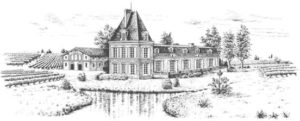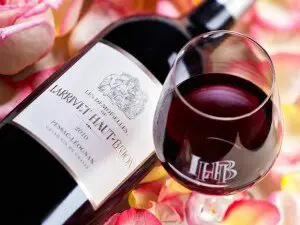 Vineyards in Bordeaux have roses nodding in the breeze at the end of the rows of grape vines and beautiful though they are, the roses are there for a practical reason. Roses and vines are both susceptible to the same diseases and as the rose is more sensitive than the vine it acts as an early warning system.
Vineyards in Bordeaux have roses nodding in the breeze at the end of the rows of grape vines and beautiful though they are, the roses are there for a practical reason. Roses and vines are both susceptible to the same diseases and as the rose is more sensitive than the vine it acts as an early warning system.
They have been grown together for centuries in this way.
Surprisingly roses named after Bordeaux chateaux are rare but this year a new rose, created by the House of Meilland rose breeders, has been named after Chateau Larrivet Haut Brion‘s Second Wine: Les Demoiselles Larrivet Haut Brion.
Chateau Larrivet Haut Brion has been owned by the the Gervoson family since 1987 and they named their Second Wine, Les Demoiselles Larrivet Haut Brion (The Damsels of Larrivet Haut Brion) in honour of their 3 daughters: Emily, Charlotte and Valentine. Rosa Les Demoiselles Larrivet Haut Brion will form part of a unique rose garden at the chateau. The rose was ‘baptised’ by pourin g a little white wine from a magnum of the 2011 vintage over the petals.
g a little white wine from a magnum of the 2011 vintage over the petals.
The chateau lies in Pessac Leognan on a gravel ridge alongside Chateaux Haut Bailly and La Louvière.
This is an old estate but is quite separate and independent from the Chateau Haut Brion properties which lie further north. Unlike Chateau Carmes Haut Brion Larrivet was never part of the Haut Brion vineyards but acquired the name Brion as this was the local word for gravel hill.
 Meilland have been established since 1850 and remain a family owned business (the 6th generation is now at the helm). We may not have heard of Meilland over here in the UK but we are all familiar with one of their most famous roses: Peace.
Meilland have been established since 1850 and remain a family owned business (the 6th generation is now at the helm). We may not have heard of Meilland over here in the UK but we are all familiar with one of their most famous roses: Peace.
It was developed by Francis Meilland in the years 1935 to 1939. When Meilland foresaw the German invasion of France he sent cuttings to friends in Italy, Turkey, Germany, and the United States to protect the new rose.
It is said, that it was sent to the US on the last plane available before the German invasion, where it was safely propagated by the Conard Pyle Co during the war.
In early 1945 Meilland wrote to Viscount Alanbrooke to thank him for his key part in the liberation of France and to ask if he would give his name to the new rose.
Alanbrooke declined saying that, though he was honoured to be asked, his name would soon be forgotten and a much better and more enduring name would be “Peace”.
The new rose’s name was announced on 29 April 1945. This was the very day that Berlin fell, officially considered the end of the war in Europe. Later that year Peace roses were given to each of the delegations at the inaugural meeting of the United Nations, each with a note which read:
“We hope the ‘Peace’ rose will influence men’s thoughts for everlasting world peace”.
Since then it is said that over 100 million plants have been sold. (My parents used to have Peace growing in their garden!). I know I will never have a rose named after me but my favourite ‘rose’ quote comes from Eleanor Roosevelt:
“I once had a rose named after me and I was very flattered. But I was not pleased to read the description in the catalogue: no good in a bed, but fine up against a wall.”
However I think it’s a great idea to name roses after chateaux, especially given their long standing connection!

